Released on August 18, 2010
(Next Release on August 25, 2010)
Northeast States move to reduce
sulfur content in heating oil
The Northeast region of the U.S., represented by the New England and Central Atlantic regions shown in Figure 1, typically account for over 80 percent of U.S. heating oil sales. As shown in Figure 2, the top 5 consuming States, in rank order, are New York, Massachusetts, Pennsylvania, Connecticut, and New Jersey. Heating oil is a distillate fuel, coming from the same boiling-range portion of crude oil as diesel fuel. However, unlike diesel fuel used in transportation, heating oil has no Federal sulfur content restrictions. Several northeastern States are leading a transition to cleaner burning heating fuels by decreasing sulfur content in heating oil. Table 1 outlines current State actions in this regard. It indicates that some States are reducing sulfur content to the ultra low sulfur levels now required in highway diesel fuels.
Figure 1. The U.S. Northeast Region
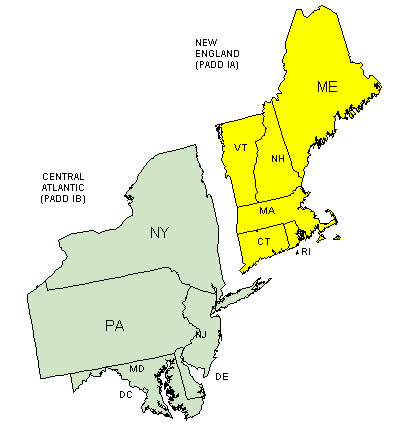
Source: Energy Information Administration (EIA)
Figure 2. U.S. Residential Heating Oil Consumption
is Concentrated in the Northeast
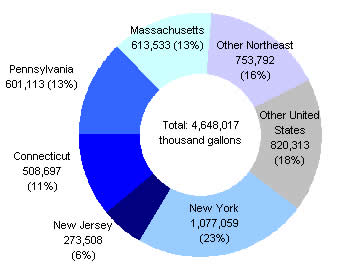
Source: Fuel Oil and Kerosene Report 2008
The States are motivated by the desire for cleaner burning fuels that will be less polluting as well as having lower maintenance costs for fuel dealers and consumers. However, while maintenance costs may be lower, ultra low sulfur distillate fuels are more expensive to produce, transport, and store, Over the past two years, ultra low sulfur diesel fuel has typically sold for 5 to 10 cents per gallon more than high sulfur heating oil on the New York Harbor spot wholesale market.
Initially, the change to ULSD for heating oil may limit import supply sources, as many parts of the world do not produce ultra low sulfur distillate fuels. During the winter (December through February), high sulfur distillate imports into the East Coast account for about 20 percent of this region’s total heating oil demand on average, and about 50 percent of distillate imports. Furthermore, during past cold snaps when supplies run short, high sulfur imports have provided most of the relief to the increased heating oil demand.
The transition will present other challenges. Some refineries supplying the Northeast with heating oil will need to make investments to produce ultra low sulfur distillate fuel for this market. Terminal transitions to low sulfur heating oil will need to be made, as well as changes to supplies of low sulfur additives or blending components to create winter-blend heating oil.
Table 1. Current Northeast State Regulatory Activities to Reduce Sulfur in Heating Oil
City or State |
Action |
Effective Date |
Status |
| CT | Mandates a schedule to lower sulfur content in heating oil and increase biodiesel blending, contingent on the passage of similar measures in NY, RI, and MA.* | 7/1/2011 | Legislation passed, but contingent on other States |
| ME | Reduces sulfur content to 50 ppm starting January 1, 2016, and no more than 15 ppm starting January 1, 2018; distillate fuel used for manufacturing purposes is exempted. Reduces sulfur content in residual fuel oil to 0.5 percent by weight effective January 1, 2018. | 1/1/2016 | Legislation passed; rulemaking proposed (in public comment period) |
| NJ | Reduces sulfur content to 500 ppm starting July 1, 2014, and no more than 15 ppm starting July 1, 2016. | 7/1/2014 | Rulemaking proposed (administratively complete, awaiting signature) |
| NJ | Cuts allowable sulfur level in heating oil to 15 ppm.** | 7/1/2011 | Legislation proposed |
| NY | Cuts allowable sulfur level in No. 2 Heating Oil to 15 ppm. | 7/1/2012 | Legislation passed |
| NY City | Cuts allowable sulfur level in No. 4 Heating Oil to 1,500 ppm. | 10/1/2012 | Legislation passed |
| PA | Cuts allowable sulfur levels to: 15 ppm for No.2 Heating Oil; 0.25 percent for No.4 heating oil; 0.5 percent for No. 5, No. 6 and heavier oils. | 5/1/2012 | Rulemaking proposed (in public comment period) |
| PA | A bill introduced in the PA legislature would require all heating oil used for residential, commercial and industrial heating to have a sulfur content of 15 ppm or below. | 5/1/2011 | Legislation proposed |
| DC, DE, MA, MD, NH, RI, VT | No actions to lower sulfur content are currently proposed.*** | _ |
_ |
| *Requires: sulfur reductions to 50 ppm by 7/1/2011 and 15 ppm by 7/1/2014; and increased biodiesel blending to 2 percent in 2011 and 20 percent by 2020. **Includes all heating oil sold for residential, commercial or industrial uses within the State. ***Measures to lower sulfur content have been discussed in some States, but formal actions have not yet been taken. |
|||
Retail Gasoline and Diesel Prices Decrease
The U.S. average retail price for regular gasoline decreased almost four cents from last week to $2.75 per gallon but was $0.11 per gallon higher than this time last year. Prices were down throughout the country except for a gain of a cent to $2.80 per gallon in the Rocky Mountains. East Coast and Gulf Coast prices each lost three cents to fall to $2.68 per gallon and $2.61 per gallon, respectively. The Midwest registered the largest price decrease, seven and a half cents, to settle at $2.68 per gallon. The West Coast prices remained the highest in the Nation after dropping less than a penny to average $3.10 per gallon, while California prices declined less than a cent to remain at $3.17 per gallon.
Retail diesel fuel prices fell a penny to $2.98 per gallon, $0.33 per gallon above last year. Price changes were mixed, with the East Coast falling two cents to average $2.98 per gallon. The Midwest and Gulf Coast prices were down by more than a penny to $2.95 per gallon and $2.93 per gallon, respectively. The Rocky Mountain region tallied the largest price increase, moving two cents higher to $3.01 per gallon. West Coast prices were the highest in the country, gaining half a cent to settle at $3.13 per gallon, while California prices increased slightly to $3.19 per gallon.
Propane Stocks Post Robust Build
U.S. inventories of propane grew by 2.4 million barrels last week to end at 59.8 million barrels. The largest stock build was realized in the Midwest region with 1.3 million barrels of new inventory. The Gulf Coast regional stocks grew by 1.1 million barrels and the Rocky Mountain/West Coast stocks added 0.1 million barrels of propane. The East Coast region was down slightly. Propane production has averaged 1.1 million barrels per day over the past four weeks. Propylene non-fuel use inventories represented 4.3 percent of total propane/propylene stocks.
Text from the previous editions of “This Week In Petroleum” is accessible through a link at the top right-hand corner of this page.
| Retail Prices (Cents Per Gallon) | |||||||
 |
 |
||||||
| Retail Data | Changes From | Retail Data | Changes From | ||||
| 08/16/10 | Week | Year | 08/16/10 | Week | Year | ||
| Gasoline | 274.5 | Diesel Fuel | 297.9 | ||||
| Spot Prices (Cents Per Gallon*) | |||||||||||||||||||||||||||||||||||
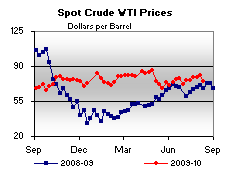 |
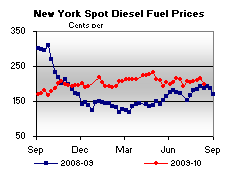 |
||||||||||||||||||||||||||||||||||
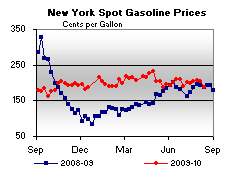 |
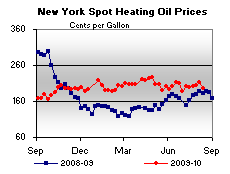 |
||||||||||||||||||||||||||||||||||
|
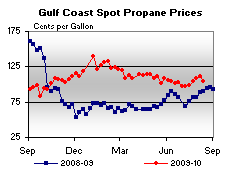 |
||||||||||||||||||||||||||||||||||
| *Note: Crude Oil WTI Price in Dollars per Barrel. | |||||||||||||||||||||||||||||||||||
| Stocks (Million Barrels) | |||||||
 |
 |
||||||
 |
 |
||||||
| Stocks Data | Changes From | Stocks Data | Changes From | ||||
| 08/13/10 | Week | Year | 08/13/10 | Week | Year | ||
| Crude Oil | 354.2 | Distillate | 174.2 | ||||
| Gasoline | 223.3 | Propane | 59.821 | ||||